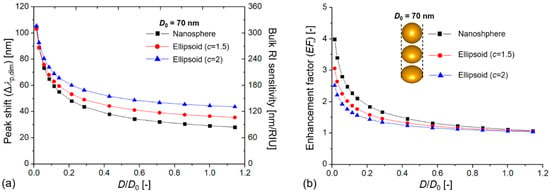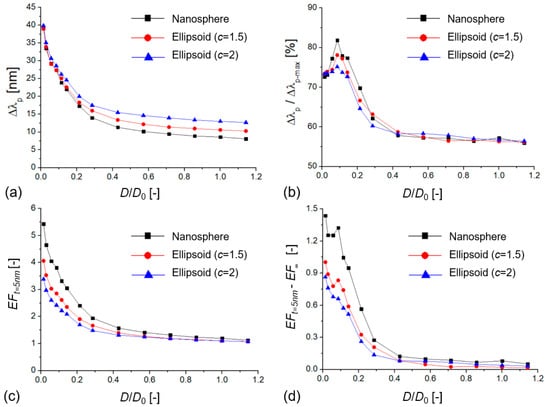1. Error in Figure/Table
In the original publication [], there was a mistake in Figures 3 and 6 as published. The unit of D/D0 (in the axes labels) is indicated as (nm), while it should correctly be dimensionless (-). The mistake only involves the figures; in the text and in the figure captions D/D0, was always correctly referred to as dimensionless. The corrected Figure 3 and Figure 6 appear below.

Figure 3.
(a) Extinction peak shift of coupled plasmonic dimers () and their calculated bulk refractive index sensitivity (RIS) as a function of the dimensionless D/D0 value, where D is the interparticle distance, and D0 is the particle diameter (D0 = 70 nm). (b) Calculated bulk enhancement factor (EF∞) values compared to single, uncoupled particles with the same size as a function of D/D0.

Figure 6.
(a) Extinction peak shift () of different dimer arrangements as a function of the dimensionless D/D0 value (D0 = 70 nm) with a dielectric layer of 5 nm (nl = 1.5 in water medium, with n = 1.33). (b) Relative extinction peak shift as a function of the dimensionless D/D0 value, where is calculated as the peak shift upon the RI of the medium changing from 1.33 to 1.5. (c) Enhancement factor (EFt=5nm) as a function of D/D0. (d) Difference between surface and bulk enhancement factors (EFt=5nm − EF∞) as a function of D/D0.
2. Text Correction
There were two textual errors in the original publication.
On page 4, in one instance, RISdim was written instead of .
A correction has been made to “3. Results and Discussion”, first paragraph:
“By depositing a dielectric layer of 5 nm thickness and nl = 1.5, the experienced extinction peak shifts were = 6.1 nm and = 18.2 nm (Figure 2b), corresponding to an enhancement of 2.98 (EFt=5nm)”.
On page 6, in one instance, t = 7 nm was written instead of t = 5 nm.
A correction has been made to “3. Results and Discussion”, seventh paragraph:
“The practical meaning of EFt is, for example, that dimer nanospheres of 70 nm diameter and 10 nm gap provide a 3.2 times higher signal compared to uncoupled spheres of the same size with t = 5 nm layer thickness”.
The author apologizes for any inconvenience caused and states that the scientific conclusions are unaffected. The original publication has also been updated.
Reference
- Bonyár, A. Maximizing the Surface Sensitivity of LSPR Biosensors through Plasmon Coupling—Interparticle Gap Optimization for Dimers Using Computational Simulations. Biosensors 2021, 88, 527. [Google Scholar] [CrossRef] [PubMed]
Publisher’s Note: MDPI stays neutral with regard to jurisdictional claims in published maps and institutional affiliations. |
© 2022 by the author. Licensee MDPI, Basel, Switzerland. This article is an open access article distributed under the terms and conditions of the Creative Commons Attribution (CC BY) license (https://creativecommons.org/licenses/by/4.0/).